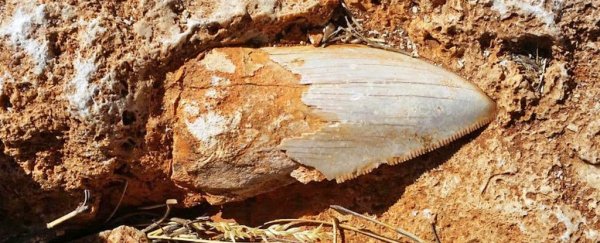A piece of pointed, fossilised tooth, which once belonged to a huge shark that dwarfed even the great white, long sat undisturbed in a remote, secret location in Western Australia.
Until last week. Wildlife officials said the megalodon tooth, believed to be about 1.6 million years old, had been stolen from its resting place in the vast Cape Range National Park on Australia's Ningaloo Coast.
Few people knew the exact location of the ancient fossil, said Arvid Hogstrom of Western Australia's park and wildlife agency, and it is unclear who the thief is.
"It was definitely a secret. … But it only takes one person to tell the wrong person and we end up where we are now," Hogstrom told the Australian Broadcasting Corporation on Monday.
"It could be someone who doesn't know what they've taken. It could be an amateur collector who wants to add to their collection, or it could be someone who wants to trade it on the black market."
A member of the public told wildlife rangers Friday that the tooth was missing.
Hogstrom said the fossil was stolen just as his team was figuring out ways to secure it.
"We've been looking at everything from bulletproof glass covers and other sorts of cages to enclose it," he told the ABC. "But obviously someone's got in there before we've been able to [secure it]."
This ancient shark species, whose name literally means "giant tooth," grew to about 15 metres (50 feet) long. That's three times the size of an adult female great white shark, which can be about 5 metres (16 feet) long.
A megalodon weighed more than 18 tonnes (20 tons), roughly three times the weight of a Tyrannosaurus rex.
"A great white is about the size of the clasper, or penis, of a male megalodon," Peter Klimley, a shark expert and professor at the University of California at Davis, told National Geographic in 2008.
Much of what researchers know about megalodon sharks is based on the fossilised remains of its teeth.
Researchers say it preyed on giant prehistoric turtles and whales, which a megalodon could chew with a force between 10,886 to 18,143 kilograms (24,000 to 40,000 pounds). That's strong enough to crush a car.
"Megalodon's killing strategy was to bite the tails and flippers off large whales, effectively taking out their propulsion systems," Stephen Wroe, then of the University of South Wales in Australia, told National Geographic in 2008.
Scientists say this shark species went extinct about 2 million years ago, during the middle of the Miocene era, though they have only speculated as to why. One theory is that megalodons were unable to adapt as the temperature of the Earth's oceans dropped.
Last year, 7-year-old Foster Frazier found a five-inch megalodon tooth while vacationing with his family in North Myrtle Beach in South Carolina.
"His father, myself and his younger brother were downstream from him at the time and heard him yelling what he'd found and saw him holding it up. We were speechless," the boy's mother, Tina Frazier, told the Myrtle Beach Sun News.
In 2013, megalodon sharks were the subject of a Discovery Channel documentary that was based on the notion that the ancient shark might still be alive.
The film featured actors pretending to be scientists on the hunt for a nearly 21-meter-long (70-foot) megalodon off the coast of South Africa, according to National Geographic.
The documentary, titled Megalodon: The Monster Shark Lives, angered many, including scientists.
"If this megalodon special had aired on the Syfy Channel, I probably would have loved it," David Shiffman, then a doctoral student studying shark ecology, told National Geographic.
"But Discovery bills itself as the premier science education television station in the world, and they're perpetuating this utter nonsense."
2018 © The Washington Post
This article was originally published by The Washington Post.
